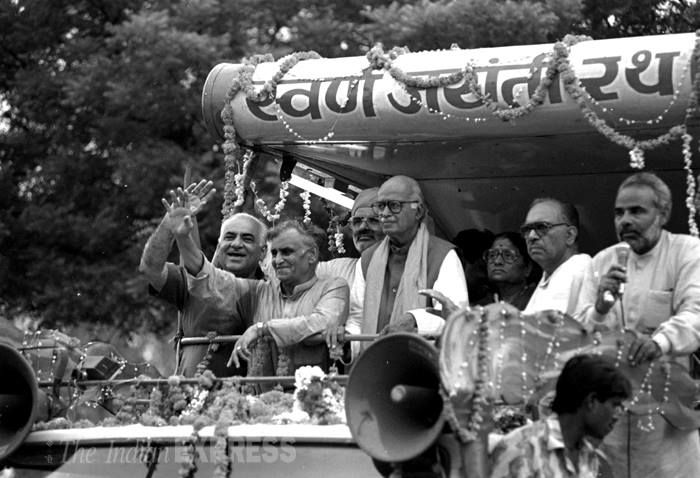November 9, 2019 has become a date of huge religious significance for crores of Lord Ram devotees across India, even as the Supreme Court of India pronounced a historic verdict on the 134-year old legal dispute over the Ram Janambhoomi. This has finally paved way for the construction of a grand Ram Mandir at Lord Ram’s birthplace in the ancient city of Ayodhya. The apex court held day-to-day hearing in the matter, and the Constitution Bench led by CJI Gogoi decided that the Hindu parties were able to prove a better title to the disputed site in Ayodhya, after appraising evidences adduced by the two sides.
The Supreme Court verdict has finally made the construction of a grand Ram Mandir at Lord Ram’s birthplace a reality. A grand Ram temple is all set to become a reality after a 491-year long wait, and a protracted 134-year long legal battle for the construction of a temple at Lord Ram’s birthplace. The Ram Janambhoomi movement gathered steam in the mid twentieth century, however what kept the Ram Mandir movement alive since the late 1980s till the pronouncement of the apex court verdict has been BJP’s continuous and effective activism. The BJP had adopted the Ram Mandir issue as a central tenet of its ideology in the 1989 Palampur resolution. During this Resolution, the party had stated, “According to all available records, Mughal emperor Babar visited Ayodhya in 1528, destroyed the temple situated at the site believed to be Rama-Janmasthan, and constructed a mosque in its place.”
The Ram Mandir movement got a headstart in the 1980s when the VHP, the RSS and the BJP galvanized a huge campaign for the restoration of the Ram Mandir, the Rajiv Gandhi government opened the gates of the premises once again, fearing an electoral loss due to mass resentment among the Hindus.
Giving further momentum to the Ram Janambhoomi movement, the BJP also organised the Ram Rath Yatra led by the then party president, Lal Krishna Advani from September 25 to October 30 in the year 1990. The journey had started from the Somnath temple in the state of Gujarat and rolled through the country’s heartland, even as thousands of people joined in during the course of the rath yatra.
Party veteran, Murli Manohar Joshi and the present BJP Vice-president Uma Bharti were also the other leaders who led from the front and kept the Ram Mandir issue alive. Ram Mandir became a mainstream issue only in the recent past. When these senior BJP leaders brought it up in the late 80s and early 90s, they faced the challenge of political isolation and criticism, which they successfully endured at that time and even in the succeeding decades.
The BJP had to face a political setback on account of its activism in favour of a grand temple at the Ram Janambhoomi site in Ayodhya. In 1996, the party had emerged as the single largest party, and yet it failed to form a government at the centre. The polity of India was, and to a large extent continues to be, dominated by the so-called secular parties. In such circumstances, the BJP failed to secure any allies, and despite a popular tilt in its favour, it failed to come into power. However, this did not stop the BJP from continuing with its Ram Mandir campaign. Since 1996, the Ram Mandir has consistently featured on BJP’s election manifesto, which shows that despite threats of isolation by other political parties at the country’s political landscape, the party has refused to give up on its core ideological goal, that is, construction of a grand Ram temple at Ayodhya.
A striking feature of the BJP’s enthusiastic Ram Mandir campaign has been the reconciliation of its activism with the Constitutional values of India. Take for example, the 2019 Parliamentary polls manifesto of the BJP. On the issue of Ram Mandir, the manifesto had stated, “We reiterate our stand on Ram Mandir. We will explore all possibilities within the framework of the Constitution and all necessary efforts to facilitate the expeditious construction of the Ram Temple in Ayodhya.” The BJP rightly positioned the construction of a Ram Temple at Ayodhya as a matter of great cultural importance and significance for India. However, the party was able to drive a balance between the Ram Mandir agenda and the basic Constitutional values and principles. What it stated in its manifesto was also clearly in line with this stance. Through its manifesto, the BJP promised to confine itself within the framework of the Constitution in its attempts to facilitate timely construction of the Ram Mandir at Ayodhya.
The BJP chose to persist with the Ram Mandir issue, because it was a matter of principle and ideology for the party. It never made it a matter of sheer political or electoral propaganda. This is the reason why Modi government did not transgress the Constitutional limits even when the core BJP supporters were getting seemingly disenchanted and impatient. They had even demanded an Ordinance in this matter, but the matter has finally been decided by a Court of law. The matter was in the nature of a title dispute and it was only appropriate that the judiciary decided it, rather then the government going out of the way to bring an Ordinance. Notwithstanding, the patient displayed by the BJP in this matter, the fact remains that it was the saffron party’s activism in this matter, which ensured that Ram Mandir remained a matter of public importance, demanding effective and timely justice. This clearly went a long way in ensuring that the sentiments of crores of Lord Ram devotees in the country were upheld, even as the apex court verdict has paved the way for the construction of a grand Ram Mandir.
